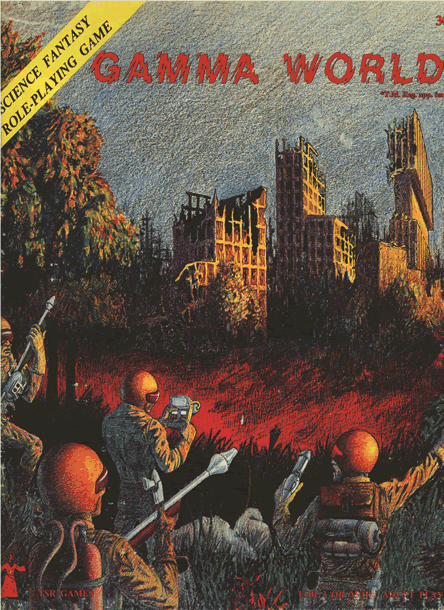 The classic D&D line contains some of the worst edited combat rules in game design history. To begin with, everyone seems to interpret them differently. Furthermore, referees of the bad old days tended to take incomplete and incoherent rule sets to make a great many special modifications of their own. The end result of this is… nobody seems to know how anything is meant to be run or what anyone was actually doing at any given time. And the chaos intensifies when people start projecting on to the past assumptions that were wired into gamers by the later editions.
The classic D&D line contains some of the worst edited combat rules in game design history. To begin with, everyone seems to interpret them differently. Furthermore, referees of the bad old days tended to take incomplete and incoherent rule sets to make a great many special modifications of their own. The end result of this is… nobody seems to know how anything is meant to be run or what anyone was actually doing at any given time. And the chaos intensifies when people start projecting on to the past assumptions that were wired into gamers by the later editions.
Fortunately, the first edition Gamma World rules aren’t like all that. Rather than being one of many contradictory takes on a game that people will not ever finish arguing about, Gamma World reads like it was actually meant to be understood.
- The surprise rules are completely explained: both sides have a six sided die rolled for them by the referee. A one or a two for a side indicates that they are surprised. “If neither side was surprised, the side that had the higher die roll ha the option to first strike.” No weird bonuses. No odd rule benders. No baroque elaborations. Just a good, clean, and thoroughly playable rule. (How does this square with the notes indicating that the character with the higher dexterity automatically gaining the initiative when facing off with against someone with a lower dexterity score? Okay, you got me there!)
- Initiative is by sides, which is of course way faster to play than individual initiative. Each round, initiative is rolled for again, but get this. When a makes its attacks, everyone declares their actions. The referee then evaluates the results of each attack. When both sides have gone, the results are “then imagined as if everything were happening at once.” If you wanted a system where there was a one to one correspondence between player actions, die rolls, and game results, this is not it!
- Because this is a very rough abstraction that is more than a little unfair to the poor creatures that are annihilated before even getting to take a turn, there is one little tweak here. Characters that are only mildly dead– ie, the amount of overkill damage was only half of the hit points they had left– then as an act of gaming mercy, they get a “dying shot”.
So far we’re on well trod ground here. Other than the referee getting to roll all of the dice, this is not going to be too far out there.
But check this out:
Most combat, of course, occurs between more than two combatants. When several beings are involved on each side of a combat situation, combatants must first be given specific opponents. Combat is then resolved for each attacker, one at a time as detailed above. If the two opposing sides are equal in number, the referee can simply pair them off randomly. If the two sides are unequal in number, the referee has two options. He can pair them off randomly as above, making sure that everyone is attacking someone. If miniature figures (or simply paper markers) are being used to “set the scene” of the combat situation, the referee can allow combatants to attack whoever is closest. In either case, two important points should be recognized about unequal combat. First, unless a combatant can attack more than once (such as a many-limbed being able to attack with each of its limbs every round), some combatants will not be attacked. Second, when one is attacking two or more defenders, there is no choice as to who gets hit — that is determined randomly.
 Now, you are going to have a hard time getting contemporary players to let go of their inalienable rights to choose whom to smite in old school melee combat. But this should make it crystal clear just how chaotic all of this is assumed to be and just how far all of this is from anything remotely like counting squares and determining if anyone has triggered an attack of opportunity or whatnot. This isn’t that sort of game.
Now, you are going to have a hard time getting contemporary players to let go of their inalienable rights to choose whom to smite in old school melee combat. But this should make it crystal clear just how chaotic all of this is assumed to be and just how far all of this is from anything remotely like counting squares and determining if anyone has triggered an attack of opportunity or whatnot. This isn’t that sort of game.
If you’re going to run this game, at the very least look out for situations where you can rule that a character facing off against two or more opponents really does have to roll randomly to determine which foe he ends up hitting. When you go back and reimagine everything as if it happened simultaneously, then I bet you that the narrative that emerges will make for more sense than the combats of people that do it the other way.
And if you’d like an Appendix N inspired rule that will not only set your Gamma World combat apart from the many D&D variants, but also differentiate it from later editions of Gamma World that dropped the ball, check this out:
Successful use of mental powers in a combat situation also works towards increasing a being’s mental strength in the following manner: for every five successful mental attacks (those which cause damage), the attacker’s mental strength increases by one point. The same increase works in a like manner for defense: for every five successful mental defenses (those attacks which do not cause damage) the defender’s mental strength increases by one point. The rationale behind these increases is that as the being’s mental capacities grow more proficient in offensive and/or defensive operation, the mind develops new channels for projecting its powers.
That’s of course straight out of Sterling Lanier’s Hiero’s Journey. And if you don’t play Gamma World that way, you’re doing it wrong!
Please give us your valuable comment